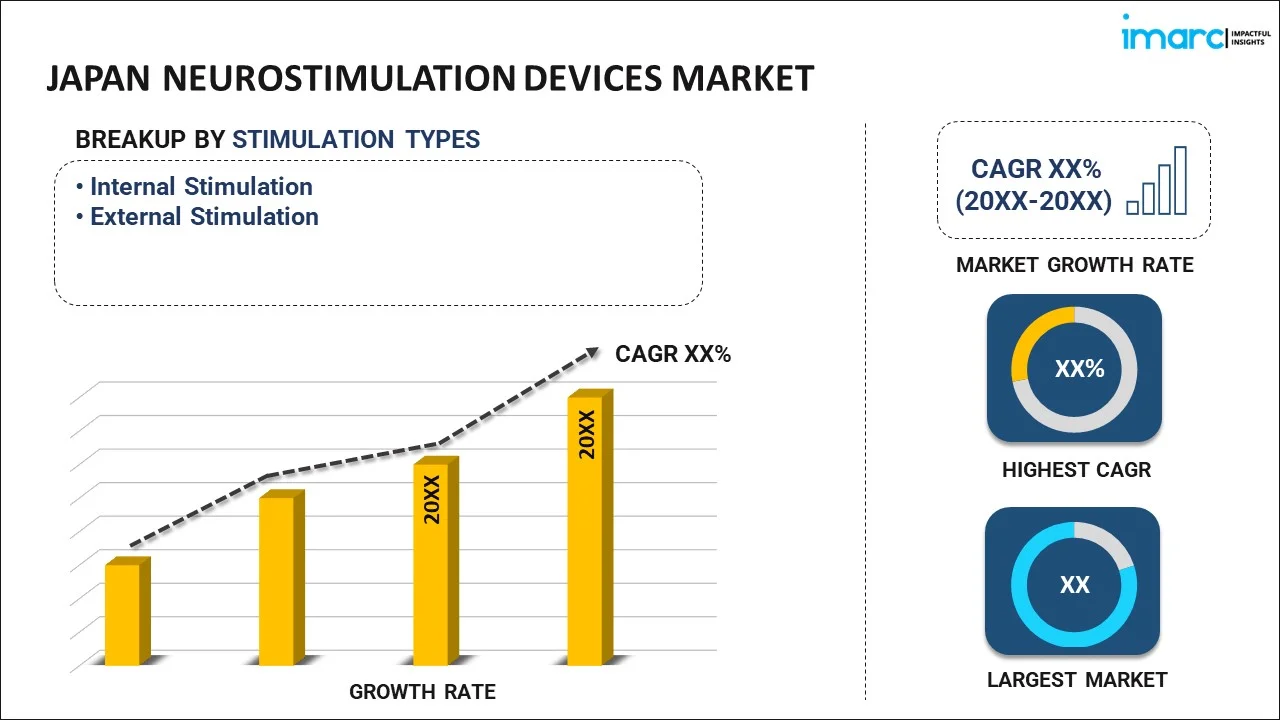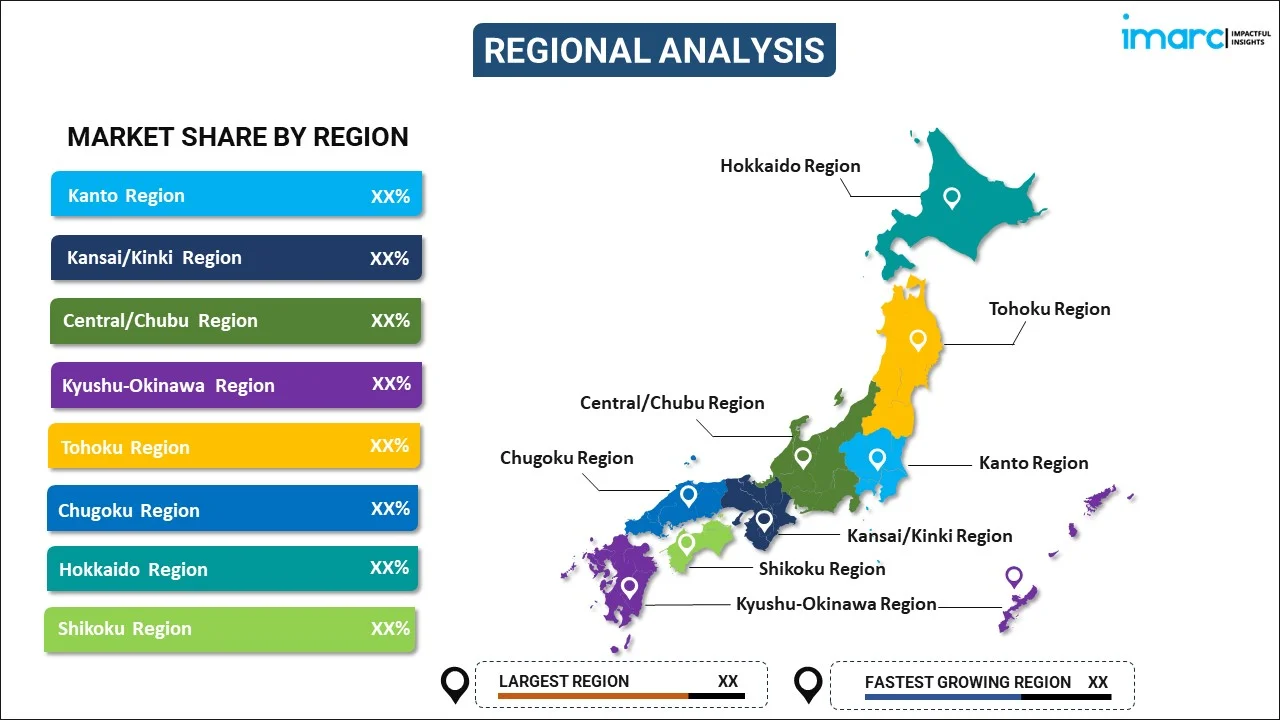
Japan Neurostimulation Devices Market Report by Stimulation Type (Internal Stimulation, External Stimulation), Device Type (SCS (Spinal Cord Stimulation) Devices, DBS (Deep Brain Stimulation) Devices, SNS (Sacral Nerve Stimulation) Devices, VNS (Vagus Nerve Stimulation) Devices, GES (Gastric Electrical Stimulation) Devices, Transcutaneous Electrical Nerve Stimulation Devices, Transcranial Magnetic Stimulation Devices, and Others), Application (Pain Management, Epilepsy, Essential Tremors, Urinary and Fecal Incontinence, Depression, Dystonia, Parkinson’s Disease, and Others), End User (Rehabilitation Centers, Hospitals, Medical Clinics, and Others), and Region 2025-2033
Market Overview:
Japan neurostimulation devices market size reached USD 874.3 Million in 2024. Looking forward, IMARC Group expects the market to reach USD 2,483.5 Million by 2033, exhibiting a growth rate (CAGR) of 11.69% during 2025-2033. Rising prevalence of neurological disorders, burgeoning aging population, rapid technological advancements, stringent regulatory standards, surging collaborative research efforts, increasing acceptance of non-pharmacological therapies, favorable reimbursement policies, and strategic industry partnership represent some of the key factors driving the market growth.
|
Report Attribute
|
Key Statistics
|
|---|---|
|
Base Year
|
2024 |
|
Forecast Years
|
2025-2033 |
|
Historical Years
|
2019-2024
|
| Market Size in 2024 | USD 874.3 Million |
| Market Forecast in 2033 | USD 2,483.5 Million |
| Market Growth Rate (2025-2033) | 11.69% |
Neurostimulation devices are sophisticated medical instruments designed for the precise modulation of the nervous system through controlled electrical impulses. They are strategically placed near specific nerve pathways or brain regions to exert precise stimulation, effectively influencing neural activity. Their applications span diverse medical fields, including pain management, neurological disorders, and mental health conditions. In the realm of pain management, neurostimulation devices have demonstrated effectiveness in alleviating chronic pain by interrupting pain signals. For neurological disorders, such as Parkinson's disease, they offer a means to regulate abnormal brain activity. Additionally, they help in treating mood disorders like depression by targeting mood-regulating circuits. A primary advantage of neurostimulation devices lies in their non-invasive nature, offering a safer alternative to surgical procedures. This minimizes the associated surgical risks and accelerates recovery. Moreover, patients can exercise greater control over their treatment, allowing for adjustments in stimulation parameters, enhancing their overall experience, and contributing to improved outcomes. These devices are available in various types, each tailored to specific medical conditions, such as spinal cord and deep brain stimulators.
Japan Neurostimulation Devices Market Trends:
The Japan neurostimulation devices market is influenced by several key drivers, such as the rising prevalence of neurological disorders, including Parkinson's disease and epilepsy. Additionally, the burgeoning geriatric population in Japan underscores the need for innovative therapeutic solutions, further amplifying market growth. Furthermore, increasing awareness about the benefits of neurostimulation therapies among both healthcare professionals and patients is facilitating the market expansion. In line with this, technological advancements in neurostimulation devices, particularly in terms of precision and minimally invasive techniques, have attracted the attention of medical practitioners, fostering the market growth. Moreover, the collaborative efforts between medical device manufacturers and research institutions in the country have also resulted in the development of cutting-edge neurostimulation technologies, which is stimulating the market growth. Furthermore, the growing inclination towards non-pharmacological therapies, to mitigate the side effects associated with medications, has driven the demand for neurostimulation devices, further boosting the market growth. Apart from this, the increasing acceptance of these devices in the management of chronic pain and mood disorders and the presence of favorable reimbursement policies and robust healthcare infrastructure are fueling market expansion across the country.
Japan Neurostimulation Devices Market Segmentation:
IMARC Group provides an analysis of the key trends in each segment of the market, along with forecasts at the country level for 2025-2033. Our report has categorized the market based on stimulation type, device type, application, and end user.
Stimulation Type Insights:

- Internal Stimulation
- External Stimulation
The report has provided a detailed breakup and analysis of the market based on the stimulation type. This includes internal stimulation and external stimulation.
Device Type Insights:
- SCS (Spinal Cord Stimulation) Devices
- DBS (Deep Brain Stimulation) Devices
- SNS (Sacral Nerve Stimulation) Devices
- VNS (Vagus Nerve Stimulation) Devices
- GES (Gastric Electrical Stimulation) Devices
- Transcutaneous Electrical Nerve Stimulation Devices
- Transcranial Magnetic Stimulation Devices
- Others
A detailed breakup and analysis of the market based on the device type have also been provided in the report. This includes SCS (spinal cord stimulation) devices, DBS (deep brain stimulation) devices, SNS (sacral nerve stimulation) devices, VNS (vagus nerve stimulation) devices, GES (gastric electrical stimulation) devices, transcutaneous electrical nerve stimulation devices, transcranial magnetic stimulation devices, and others.
Application Insights:
- Pain Management
- Epilepsy
- Essential Tremors
- Urinary and Fecal Incontinence
- Depression
- Dystonia
- Parkinson’s Disease
- Others
The report has provided a detailed breakup and analysis of the market based on the application. This includes pain management, epilepsy, essential tremors, urinary and fecal incontinence, depression, dystonia, parkinson’s disease, and others.
End User Insights:
- Rehabilitation Centers
- Hospitals
- Medical Clinics
- Others
A detailed breakup and analysis of the market based on the end user have also been provided in the report. This includes rehabilitation centers, hospitals, medical clinics, and others.
Regional Insights:

- Kanto Region
- Kansai/Kinki Region
- Central/ Chubu Region
- Kyushu-Okinawa Region
- Tohoku Region
- Chugoku Region
- Hokkaido Region
- Shikoku Region
The report has also provided a comprehensive analysis of all the major regional markets, which include Kanto Region, Kansai/Kinki Region, Central/ Chubu Region, Kyushu-Okinawa Region, Tohoku Region, Chugoku Region, Hokkaido Region, and Shikoku Region.
Competitive Landscape:
The market research report has also provided a comprehensive analysis of the competitive landscape. Competitive analysis such as market structure, key player positioning, top winning strategies, competitive dashboard, and company evaluation quadrant has been covered in the report. Also, detailed profiles of all major companies have been provided.
Japan Neurostimulation Devices Market Report Coverage:
| Report Features | Details |
|---|---|
| Base Year of the Analysis | 2024 |
| Historical Period | 2019-2024 |
| Forecast Period | 2025-2033 |
| Units | Million USD |
| Scope of the Report | Exploration of Historical Trends and Market Outlook, Industry Catalysts and Challenges, Segment-Wise Historical and Future Market Assessment:
|
| Stimulation Types Covered | Internal Stimulation, External Stimulation |
| Device Types Covered | SCS (Spinal Cord Stimulation) Devices, DBS (Deep Brain Stimulation) Devices, SNS (Sacral Nerve Stimulation) Devices, VNS (Vagus Nerve Stimulation) Devices, GES (Gastric Electrical Stimulation) Devices, Transcutaneous Electrical Nerve Stimulation Devices, Transcranial Magnetic Stimulation Devices, Others |
| Applications Covered | Pain Management, Epilepsy, Essential Tremors, Urinary and Fecal Incontinence, Depression, Dystonia, Parkinson’s Disease, Others |
| End Users Covered | Rehabilitation Centers, Hospitals, Medical Clinics, Others |
| Regions Covered | Kanto Region, Kansai/Kinki Region, Central/ Chubu Region, Kyushu-Okinawa Region, Tohoku Region, Chugoku Region, Hokkaido Region, Shikoku Region |
| Customization Scope | 10% Free Customization |
| Post-Sale Analyst Support | 10-12 Weeks |
| Delivery Format | PDF and Excel through Email (We can also provide the editable version of the report in PPT/Word format on special request) |
Key Questions Answered in This Report:
- How has the Japan neurostimulation devices market performed so far and how will it perform in the coming years?
- What has been the impact of COVID-19 on the Japan neurostimulation devices market?
- What is the breakup of the Japan neurostimulation devices market on the basis of stimulation type?
- What is the breakup of the Japan neurostimulation devices market on the basis of device type?
- What is the breakup of the Japan neurostimulation devices market on the basis of application?
- What is the breakup of the Japan neurostimulation devices market on the basis of end user?
- What are the various stages in the value chain of the Japan neurostimulation devices market?
- What are the key driving factors and challenges in the Japan neurostimulation devices?
- What is the structure of the Japan neurostimulation devices market and who are the key players?
- What is the degree of competition in the Japan neurostimulation devices market?
Key Benefits for Stakeholders:
- IMARC’s industry report offers a comprehensive quantitative analysis of various market segments, historical and current market trends, market forecasts, and dynamics of the Japan neurostimulation devices market from 2019-2033.
- The research report provides the latest information on the market drivers, challenges, and opportunities in the Japan neurostimulation devices market.
- Porter's five forces analysis assist stakeholders in assessing the impact of new entrants, competitive rivalry, supplier power, buyer power, and the threat of substitution. It helps stakeholders to analyze the level of competition within the Japan neurostimulation devices industry and its attractiveness.
- Competitive landscape allows stakeholders to understand their competitive environment and provides an insight into the current positions of key players in the market.
Need more help?
- Speak to our experienced analysts for insights on the current market scenarios.
- Include additional segments and countries to customize the report as per your requirement.
- Gain an unparalleled competitive advantage in your domain by understanding how to utilize the report and positively impacting your operations and revenue.
- For further assistance, please connect with our analysts.
 Inquire Before Buying
Inquire Before Buying
 Speak to an Analyst
Speak to an Analyst
 Request Brochure
Request Brochure
 Request Customization
Request Customization




.webp)




.webp)












